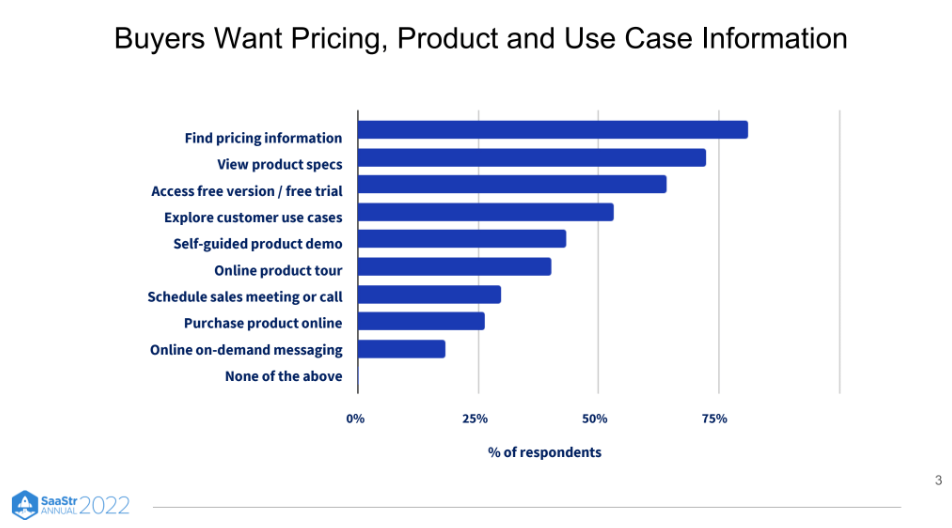Today’s customers, AKA the self-serve buyers, want to be able to access information online during the research and buying process without having to speak to a salesperson or fill out a form. Salespeople have less influence over today’s buyers, which means marketing departments play a much more significant role in driving sales than they used to.
“In 2021, 87% of buyers wanted to self-serve all or part of the buying journey… today it’s virtually 100%.” –Vinay Bhagat
How can marketers adapt to today’s self-serve buyer? Kady Srinivasan, SVP of Marketing at Klaviyo, Kathie Johnson, CMO at Talkdesk, and Cynthia Gumbert, CMO at SmartBear, join Vinay Bhagat, Founder & CEO of TrustRadius, to discuss how to drive growth in this new age.
What should marketers be thinking about when adapting to today’s buyers?
Millennials and Gen Z make up 65% of today’s buyers. These generations are less influenced by, and less trusting of, sales reps and know that if they fill out a form, they will get contacted.
“When you look at Millennials and Gen Z, they are less loyal than any other generations. 54% of them have left a brand because of one bad experience in the last year.” –Kathie Johnson
Today’s buyer is often not one person per transaction. The latest Gartner Report states that larger companies have 20 people involved in the decision-making and buying process.
Self-serve buyers want all the information provided for them to research organizations on their own. The information they are looking for independently are product information, pricing, and use case information.

Where do today’s buyers research, and how can marketers give them what they want in their journey?
With the decreasing trust in sales reps, customers research before contacting a company, often looking for opinions or recommendations from other customers or people in their network. The channels of their choice to do research varies widely for Millennial and Gen Z buyers, but often include social media.
“It’s meeting people where they are, and you can’t tell them to always come to you. They are all over the world looking for answers. Have a marketing person or team that’s ready for and responsive to that.” –Cynthia Gumbert
Buyers want to hear from people like them. Marketers should direct customers to places they can interact with existing customers. Marketers also need to ensure they are speaking in their customers’ voices.
Transparency and trust are key to today’s buyers. Placing reviews from a third party on your website is a great way to gain trust. These reviews should not be hand-selected reviews by the seller as those do not appear credible. Allowing prospects to try before they buy is one of the quickest ways to build trust and market transparently, so free trials are a major selling point.

How can marketers use customer data to engage buyers?
Today’s buyers strive to stay anonymous as long as possible, making it much harder for marketers to engage their target audience and personalize marketing. Luckily data advancements allow marketers to market softly to prospective customers.
Here are three intelligent ways to use customer data to engage buyers:
- Sales and marketing predictive intelligence platforms. Identify who your customers are and where they are in their research process. This will allow you to target and tailor your marketing to them.
- Predictive analytics. Understand which of your free trial customers are most likely to buy and have your sales team only call those prospects.
- Identify leading indicators. Break down the specific actions that most buying customers take, and then target your marketing to encourage your audience to take those actions.
“As we think about how to use customer data intelligently, I’d say it’s about identifying the leading indicators of behavior and thinking about what you can do to get them to that next step of the customer journey.” –Kady Srinivasan
How can marketers activate customers to be your company’s champion?
The most influential people in today’s market are the buyers’ networks, so creating raving fans of your company can be very lucrative. Make sure every interaction with your customers portrays your company’s values. Send swag bags when a sale is made. Have a system that rewards customers for referring and singing your praises. Make it easy for customers to like you and listen to what they have to say. The best companies do a great job of listening to customer feedback to understand patterns.
Customers today want to self-serve and avoid blatant marketing or sales. Millennials, and now Gen Z, are in positions of authority in their companies, making up most of today’s buyers. These generations rely heavily on customer reviews and seek transparency, trust, and companies that are true to their values. By understanding these core customer desires, marketers can drive growth in this new age of the self-serve buyer.


